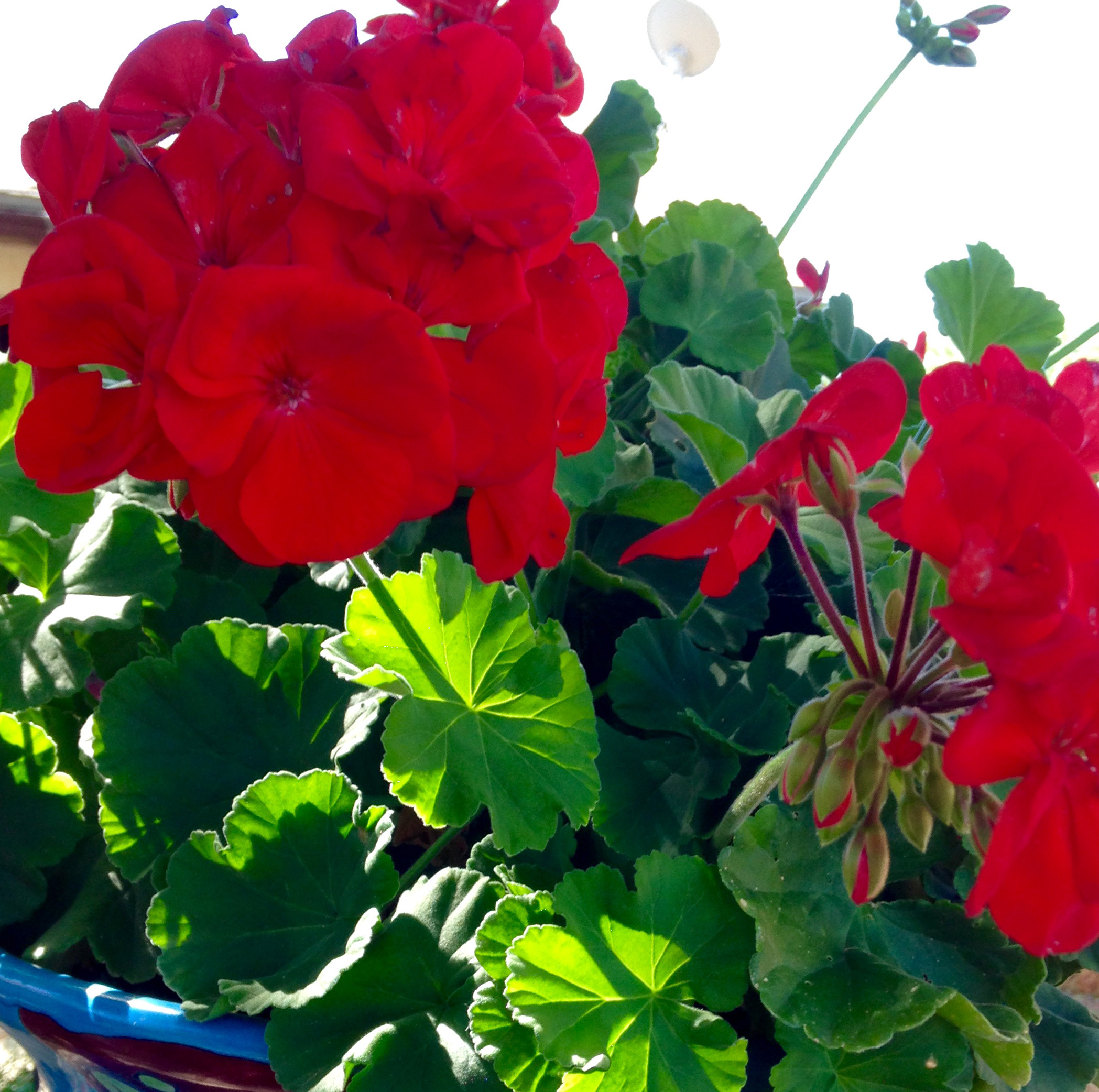Plant of the Month – Zonal Geranium

Article & Photos by Jan Koehler, SCMG
Scientific Name: Pelargonium ×hortorum L.H. Bailey (pro sp.) [inquinans × zonale]
Other Common Name: Annual geranium, geranium,
Type: Forb/herb, shrub, subshrub
Family: Geraniaceae
Native Range: South Africa
Zone: 9-12
Height: 5-24”
Spread: 12-15”
Bloom Time: Mid-Spring until hard frost
Bloom Description: Flowers can be single (5 petals) or double and come in clear white, pink, salmon, orange, red, magenta, lavender and bi-colors on flower head supported by stalks high above the leaves.
Sun: Full sun to part shade; most prolific blooming in full sun
Water: Medium
Maintenance: Medium
Suggested Use: Patio containers, window boxes, annual bedding plant, hanging baskets
Flower: Showy
Leaf: Oval leaves grow on succulent stems. The leaves often have zones of maroon or bronzy-green.
Attracts: Hummingbirds
History and Pelargonium species
The popular geraniums found at most garden centers in spring actually belong to the genus Pelargonium. These lush growing geraniums look good in a bed all by themselves, or mixed in with other annuals. They also make attractive edging plants for the flower garden. In fact, these versatile plants are perfect for any spot that calls for a splash of vibrant color through-out the season. Not surprisingly, of course, they are the popular mainstays in containers, hanging baskets and window boxes, as they thrive in pots and mix beautifully with annuals such as lobelia, vinca, petunias, sweet potato vine, nasturtium, and verbena providing a long season of relatively carefree color.
Although zonal geraniums are one of the most popular container plants, they are often confused with true geraniums, the perennial Cranesbills, Geranium sp. The confusion can be traced back to disagreements between botanists over classification and is of little importance to most gardeners, except for the distinction that perennial Cranesbill geraniums will come back each year and zonal geraniums, now classified as Pelargonium, are topical perennials usually grown as annuals. They got the name “zonal” because of the markings on their leaves. They are from the same plant family as the perennial geranium, however, Pelargonium sp. are tender perennials and not frost hardy in cold regions. The most common types fit into one of the following groups:
- Zonal –This group is loved for its big, attractive flower heads that bloom white, pink, orange, red or purple. The leaves have a dark zonal pattern on the leaves. Zonal geraniums were discovered in South Africa. Every year different color and leaf choices are found in nurseries offerings due to selective breeding for size and color. At a good source, there are Pelargonium sps. which are tulip-flowered, cactus-flowered and spiky star-shaped flowers. There are also the fancy-leaved varieties, grown more for their variegated and patterned foliage.
- Ivy-Leaf Geranium(Pelargonium peltatum) – A trailing habit and ivy-shaped leaves define this species. The flowers are smaller and less showy than zonal geraniums and the plants are often used as spillers in containers. Ivy leaf geraniums should be recommended to anyone who has ever lost a hanging basket fern to the heat and sun of a bright porch. Instead of wilting sadly, ivy geraniums respond with flowers and a nice draping form. Regular water and fertilizer will keep them blooming for months.
- Scented-Leaf Geranium (Pelargonium domesticum)- Volatile essential oils in their leaves provide the varieties in this species with its fragrant distinction mimicking lemon, rose, mint, pine, fruits and even chocolate. The flowers tend to be small and often insignificant and the leaf shapes vary. Besides their ornamental and fragrant appeal, many can also be used in cooking. Scented geraniums are best grown “lean” like herbs with just enough water to prevent wilting and minimal amount of fertilizer enabling the plant essential oils to concentrate in their leaves.
- Regal and Angel Geraniums(Pelargonium domesticum) – The Regals, also referred to as Martha Washington geraniums, are full, bushy plants with flowers in unusual colors and patterns. Angels are smaller versions of Regals. These geraniums tend to be spring bloomers and seldom, if ever, bloom a second time in a season making them less attractive and even disappointing to the gardener seeking a full summer of color.
The Zonal Geranium: Growing Tips
Soil: Zonal geraniums prefer rich soil well drained and are not terribly fussy about soil pH, but prefer a slightly acidic soil of about 5.8 to 6.5. Compost added to your soil will give them an added boost. Plant container geraniums into pots filled with container potting mix.
Light/Temperature: Plants flower best in full sun, which means at least six hours of direct sun a day. In a hot region with regular summer temperature over 90 degrees F planting geraniums in a partly shaded spot away from the intense afternoon sun may beneficial. Many geraniums do quite well in part shade, but they won’t flower as prolifically. They also weather a light frost, but will not survive a prolonged freezing period unless they are overwintered in a place that is frost free.
Fertilizer: Geraniums are heavy feeders. They benefit from a fertilizer application every two weeks or once a month at the very least. A balanced, water-soluble fertilizer such as 20-20-20, or feeding them at planting time with a time-release fertilizer that lasts all season is preferred. Regular fertilizing is especially important for container-grown plants to keep them vigorous.
Water: The key to thriving geraniums is to water them thoroughly letting the soil dry between watering cycles. Stressing them slightly by watering only after the soil has dried out completely for a day or two seems to encouraging more profuse blooming. When the season isn’t providing enough rainfall, more frequent watering is essential. During hot summer weather containers should be checked daily using either a water meter or a finger poked into the soil to a depth of 2”. If it is dry at this depth, another watering is in order.
Grooming: Deadheading spent blooms by removing the entire flower stalk and any dried or discolored leaves keep the plants looking their best for the entire season.
Propagation: Zonal geraniums can be started from seed, cuttings or transplants. Vegetative propagation is the traditional method for maintaining favorite varieties as this method insures an exact replica of the parent plant from which the cutting was taken. It is essential to use only healthy, vigorous plants.
Geraniums can easily be started from seed, although the seed is usually for F1 hybrids. These plants are often smaller than their vegetative propagation counterparts. They are found in garden centers with other annual flowers offered in multi-packs/small pots. They are usually single red, white, or pink flowers and grow well in mixed pots or en mass in well drained beds. Seed geraniums are bred to be disease resistant and to bloom well in the heat of summer. These seedlings are also important to breeding as they have the potential for manifesting new colors, sizes, shapes, and other desirable attributes unavailable by vegetative propagation.
When planning to start seeds, it is necessary to do so 8 – 10 weeks before the last frost date. They can take up to 2 weeks to germinate and should be kept warm, 70 and 75F, and moist in the process. Scarifying the seed before planting will help aid germination. Young plants should be hardened off before planting outdoors and should begin to bloom about a month after being set out.
Overwintering: Since zonal geraniums are basically tropical perennials unless the plants have been growing in a USDA Zone 9 or higher, they will require winter protection. They can be brought inside and grown as houseplants, in a bright, direct light window. Cuttings may be taken mid-summer and brought indoors, or full plants can overwinter in their dormant state which works beautifully in a weather protected location as far north as a USDA Zone 7 with a mild winter.
Having the knowledge that geraniums are omnipresent in the garden centers each spring, it is surprising to imagine why it became such a tradition to overwinter geraniums for the next season. Perhaps gardeners are a frugal lot and find it incredibly difficult to part with a perfectly good plant. Fortunately, overwintering geraniums doesn’t need to take up valuable space under lights or in bright windows. Bringing the pot indoors to a garage that does not experience freezing temperatures and allowing the plant to dry out is about the extent of the work required for overwintering. It is easy, but it is not always worth it, as with each passing season, the woodier the geranium stems become and the less prolific the geranium will flower although pruning in late spring after the plants have been watered, fertilized, started growing does produce nice plants with interesting almost bonsai type shapes and more flowers. New plants, however, will bloom most profusely in any given season. If planning on overwintering, pots no larger than 12-14” across and 10-12” deep should be used as the weight of anything larger may becomes an issue for the average sized gardener.
Pests & Problems: For the most part, zonal geraniums are not prone to insect pests, when grown outdoors. Indoors, aphids and whiteflies can become a nuisance. There are a few fungal and bacterial diseases to watch for, however, mainly stem or root rot caused by poorly drained soil. Gray mold or botrytis, especially in humid or damp weather, which causes grayish fuzz on the leaves and eventually a slimy mush probably won’t be a problem in desert climes.
Click on the links below for more information:
http://plants.usda.gov/core/profile?symbol=PEHO2
http://gardening.about.com/od/winterinthegarden/ss/Store_Geraniums.htm
http://www.flower-gardening-made-easy.com/growing-geraniums.html
